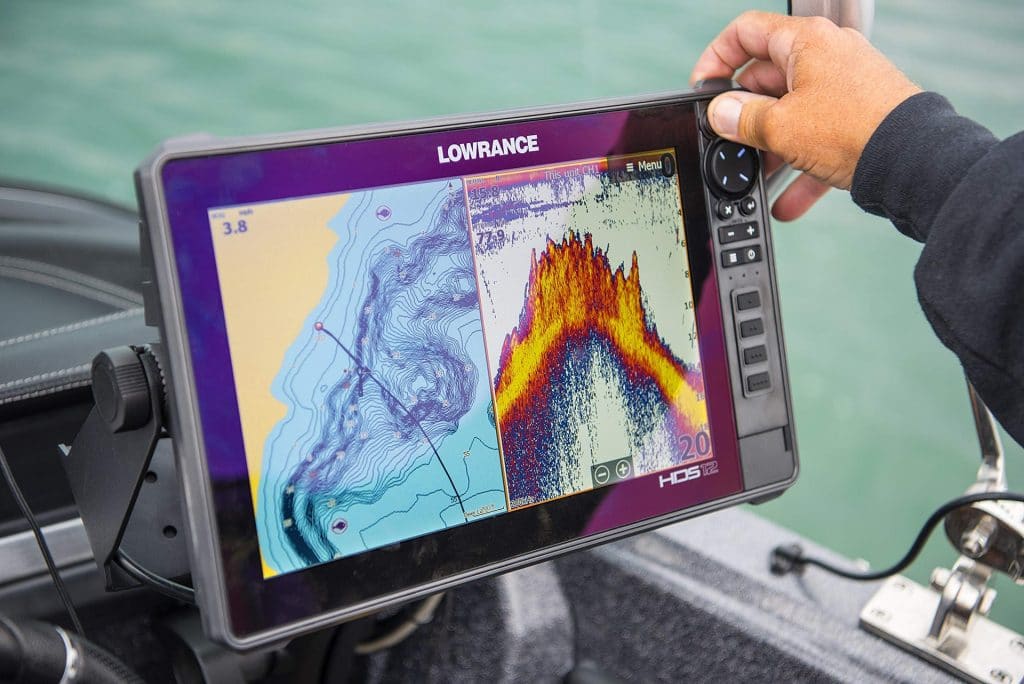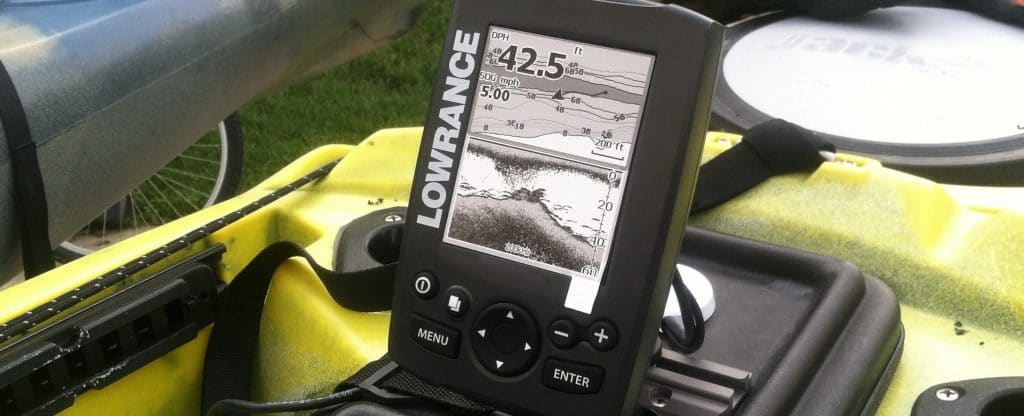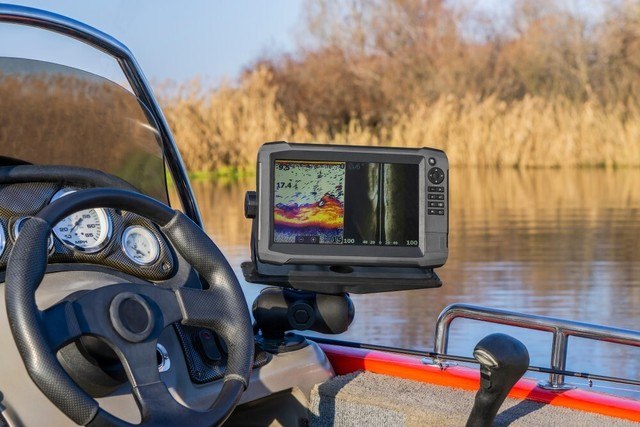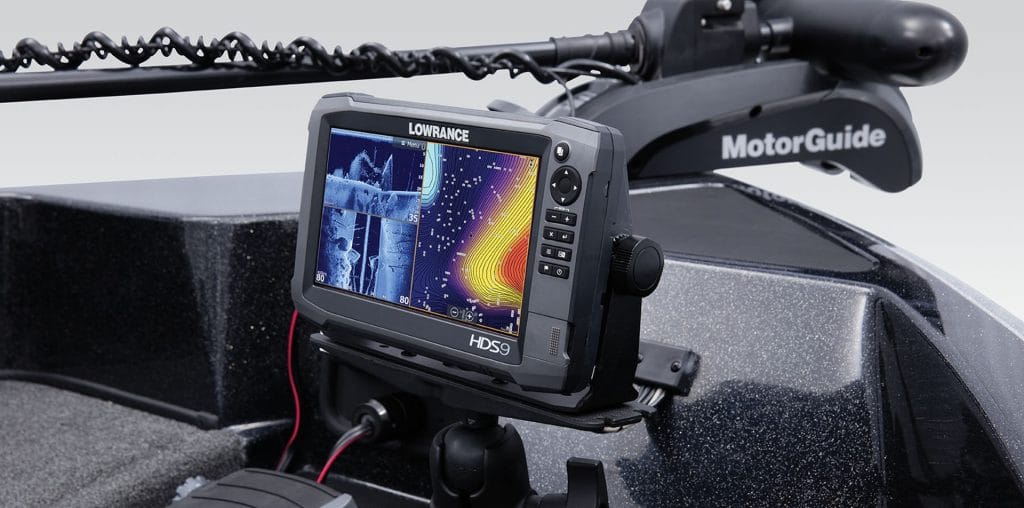

When the lakes freeze over in the dead of winter, it’s time to break out your fishing rod. Ice fishing is an age-old pastime that can reward you with fresh fish, without the need for a boat to get to the middle of your favorite lake.
Of course, it’s important to use your time out on the ice productively, which is where having the best ice fishing fish finder comes in. With a fish finder on the ice, you can find the perfect spot to drill a hole and ensure that you return home with a catch to cook up.
In order to help you find the best fish finder for ice fishing, we considered a number of features of these units. First, we looked at the weight – you need to carry it out onto the ice after all. Then we looked at the size and resolution of the display, since that makes a big difference in how well you’ll be able to see fine details like fish. We also considered the maximum depth that the fish finder can detect to and the type of sonar system it uses. Both of these play an important role in determining whether you’ll be able to target fish effectively at your favorite lake.
We spent tens of hours researching fish finders for ice fishing, poring over manufacturers’ technical specifications and studying customer reviews for popular models. The result is our pick of the six best ice fishing fish finders, highlighted in the table below. Continue reading for detailed reviews of each fish finder and our Buying Guide, which covers everything you need to know about choosing the right fish finder for you. Finally, we sum up our three overall favorite ice fishing fish finders for the upcoming winter. More features: noise reduction, zoom This fish flasher for ice fishing from Humminbird is a favorite among frequent ice fishermen. The fish flasher allows you to get a fast view of the entire lake down to 200 feet using a circular display system. While this system can take some getting used to, it’s highly effective for ice fishing as it is quite powerful at identifying fish in the middle of the water column or just above the bottom. One of the things that users love most about this fish flasher is that it’s lightweight and portable. The entire unit weighs just 5.5 pounds with the transducer and battery included. The top handle ensures that you can carry it around with a gloved hand – and you never have to remove your gloves to operate the flasher. This fish flasher is especially beloved by ice fishermen because of its dual frequency sonar and zoom functions. Depending on the depth of the lake you’re fishing in, you can set to either a low or high frequency to get better resolution. The zoom function allows you to turn up the gain, so you can better see fish once you’ve gotten an idea of where they’re located. The ICE-35 also allows you to turn off interference from other CHIRP sonar systems being used on the lake, which ensures that other fishermen won’t get in the way of your fish flasher. More features: works on 5-feet depth, zoom, accessories kit: case This fish flasher for ice fishing from MarCum is a standout in the world of ice fishing. The display uses three-color fiber optics to give you a clear view of what’s going on in the water below you, making it easy to spot fish anywhere between the ice and the lake bottom. The M-series Sonar System allows you up to 20 degrees of view, which is perfect when you’re just getting on the lake and looking for the best spot to drill your fishing hole. Once you’ve honed in on a fish, you can turn up the gain to confirm its depth before letting out your line. Users also noted that the gain can be used to adjust the flasher according to the depth of the lake – in deep lakes, turning the gain all the way up will allow you to see detail down to 160 feet. The unit can also modify its overall power output according to depth intervals, which can be set in 20, 40, 80, or 160 feet. There are two models in the MarCum M series – the M1 and the M3. The M3 doubles the available power to 2,000 watts, which is great if you tend to fish deeper lakes. However, that added power can also drain the included battery more quickly. The M3 also adds an interference elimination protocol that helps to negate false signals from nearby CHIRP sonars. This fish flasher comes with a case and battery, which lasts upwards of 30 hours in shallow lakes. While the 10-pound weight is somewhat heavy, it’s easy to carry this flasher to your fishing hole. More features: multipurpose usage, built-in mapping, GPS navigation, upgradable with SD card The Echomap fish finder from Garmin is an ideal choice for fishermen who want to use the same fish finder no matter what the season. This fish finder is designed primarily for use on a boat during the spring, summer, and fall, but it can easily be unmounted and used on an icy lake during the winter months. The nine-inch color display is what draws many fishermen to this fish finder – it offers incredibly high resolution and allows you to display downscanning, sidescanning, and CHIRP sonar outputs all on the same screen. While users felt that the buttons were a little small to use with gloves on, the menus are easy to navigate and you can largely stick to the automated settings with this fish finder. The fish finder also includes GPS functionality and comes with built-in maps for coastal fishing. However, note that lake maps are not included with the unit – you’ll need to spend an extra several hundred dollars for LakeVu mapping cards. Given the already high price of this fish finder, that can be somewhat off-putting for many fishermen. It’s worth noting that the Echomap can also be upgraded for use with a Panoptix transducer, which gives you an even wider field of view and increases the maximum depth of this unit beyond 100 feet. Again, though, this upgrade is quite expensive. Unlike other fish finders meant for boat usage, this unit is actually fairly portable. That’s thanks to the non-standard Garmin battery that this fish finder requires, which is far smaller than a standard 12-volt battery. More features: waterproof, infrared lights for camera lightsource, 8 GB SD card included, removable sun-visor, 5-6h working time This fish monitor from Eyoyo isn’t really a fish finder as much as it is a fish camera – but ice fishermen rave about its ability to help you find the best spots to fish. The setup consists of a nine-inch TFT color display and a wired waterproof camera, which is lowered into the water. The camera can be used with or without lights, as well as in infrared mode. Users were extremely impressed with the effectiveness of the camera system. With the lights on, it’s actually possible to spot fish even in relatively dark, deep water down to 100 feet. However, beware of using the camera in smaller ponds or near the bottom of lakes, as sediment and other murkiness can obliterate your view even with the lights activated. In shallow water, turning the lights off saves battery and can help to prevent fish from being scared away. The infrared mode on the camera received more mixed reviews. Many fishermen lamented the lack of a gain function on the infrared camera, without which it is almost impossible to use effectively. Some ice fishers added a second infrared camera to the existing camera to replace this functionality. The other potential pitfall to this fish camera is the battery, which is limited to a maximum of six hours. However, if you plan to be out fishing all day, it is relatively inexpensive to buy a spare battery for the monitor. The entire setup is light enough that carrying an extra battery is not a problem. More features: multipurpose usage, built-in mapping, high detailing, GPS waypoints and navigation, upgradable with SD card This highly versatile fish finder from Lowrance was designed for fishing boats, but performs just as well during the winter months. The seven-inch Solarmax display is compatible with the sun cover so that it’s easy to see even when sunlight is shining off the ice. Better yet, Lowrance offers this fish finder in display sizes ranging from five to 12 inches. Users appreciated the relatively large buttons and simple menus for controlling the fish finder, which makes it easy to operate without taking your gloves off. This ice fishing fish finder comes with a TripleShot transducer, which includes downscanning sonar, sidescanning sonar, and CHIRP. It’s possible to have all three sonar outputs displayed on the screen simultaneously, which makes it extremely simple to get a full picture of the lake’s fish hideouts after drilling an initial test hole. The 500-foot maximum depth is also plenty deep for most ice fishing expeditions. Users loved that this fish finder comes with a built-in GPS and includes high-resolution maps for over 4,000 North American lakes. That makes it simple to mark favorite fishing spots and identify where fish are likely to be before you start drilling ice holes. The fish finder also accepts SD cards so you can add commercial or custom maps. The only downside to this fish finder is that, since it’s designed primarily for use on boats, you’ll need a 12-volt battery to power it. This isn’t a huge dilemma, but it can add significantly to the weight you need to carry out onto the ice.Quick Summary
Top 6 Best Ice Fishing Fish Finders Review 2025
Humminbird ICE-35 Three Color Flasher
MarCum M Series Flashers
Garmin Echomap Chirp 94SV with Transducer
Lowrance HOOK2 Fish Finder
More features: water temperature display, waterproof, lightweight, compact
This budget-friendly fish finder from Garmin is the perfect choice for fishermen who don’t need a lot of bells and whistles. The fish finder comes with DownV scanning sonar, which provides a wide field of view while offering excellent capabilities when it comes to identifying fish. The single sonar display also makes this fish finder one of the easiest to use that we’ve come across – there’s no need to sort through multiple display screens or navigate complex menus.
We also liked that the sonar can be switched between 77 and 200 kHz frequencies depending on the depths you are fishing at. While you’re unlikely to find a lake this deep, the sonar is powerful enough to penetrate down to 1,600 feet in freshwater.
That said, this is definitely a budget fish finder that won’t appeal to every ice fisherman. The fish finder display is quite small compared to most of its more expensive competitors, and the eight-color grayscale is nothing like a full-color display when it comes to visualizing details. The 160 x 256 resolution is also relatively low, although most fishermen didn’t seem to mind this as fish are still easily distinguishable.
The fish finder is lightweight, but you’ll need a 12-volt battery in order for it to function. Still, users appreciated that this unit is waterproof and can be easily operated with gloves on.
Now that you’ve learned more about our six favorite ice fishing fish finders, how do you choose the one that’s right for you? In our Buying Guide, we’ll cover everything you need to know about fish finders for ice fishing, including the features to watch out for and how you can use your fish finder to help you land bigger fish from the ice.
Fish finders for ice fishing are universally helpful in making your fishing excursion more productive, but some fish finders are better suited for ice fishing and for specific types of lakes than others. To help you pick out the right fish finder for your favorite frozen lake, we’ll take a look at the features that go into these fish finders and explain how they can impact your fish finder’s usability.
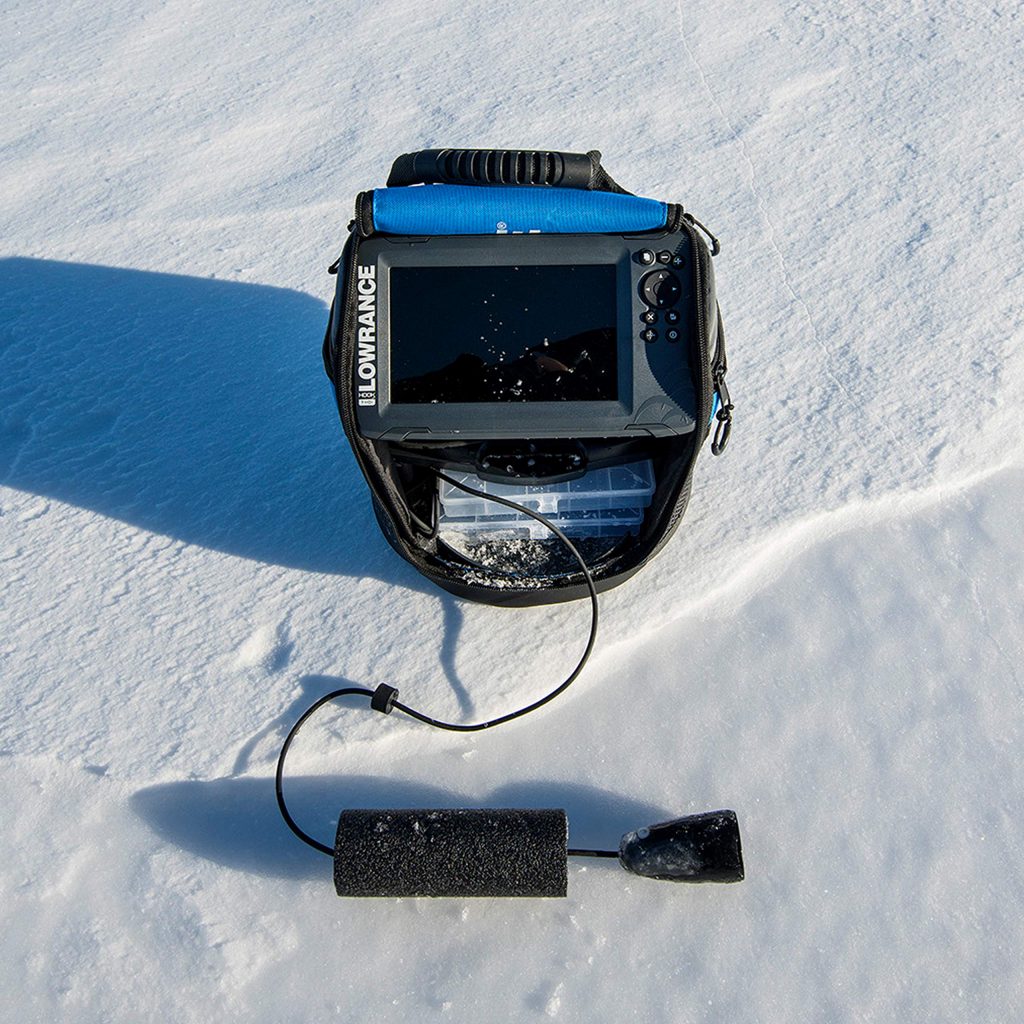
Fish finders like the kind you’d mount on a boat, like the models from Garmin 94sv, Humminbird, and Lowrance, tend to be no more than a few pounds and are easy to hike out onto the lake with. But, if you’re looking for a fish flasher like the units from Eyoyo or MarCum, weight becomes more of a concern. If you opt for one of these heavier fish finders, it may be worth investing in a heavy-duty cart to carry your gear in.
A fish finder is only as good as its display – if you can’t see the fish because the display is too small or blurry, then your fish finder won’t be of much help no matter how powerful the sonar system is. Nine-inch high-resolution displays like those on the Garmin 94sv and Eyoyo fish finders are ideal for showing details in bright colors, allowing you to quickly see what’s going on under the surface of the ice. Smaller displays like that on the Garmin Echo 151dv can be okay as well, but the lack of color can require that you need to study the display closely to identify fish.
Keep in mind that many newer fish finders offer touchscreens to allow you to control the displays and settings. Touchscreens are great in the summer, but they are less than ideal in the winter when removing your gloves means freezing your fingers. Look for fish finders that can be controlled with large buttons that are easy to use with gloves on.
The beam angle of the sonar system included with your fish finder plays a big role in how useful your fish finder will be. Fish finders that offer relatively narrow beam angles are able to penetrate deeper into the water, making them ideal for finding fish right below your current position even if the lake is relatively deep at that point.
Wide sonar beam angles, often found on side scan sonar modules, give you a much wider field of view into the water beneath you. This is great if you’re not exactly sure where to look and need a relatively wide search radius. However, the wider the beam angle, the less deep the signal will penetrate in the water and the blurrier the resulting images will be.
Ideally, your sonar system includes both down scanning and side scanning sonar signals. Our Editor’s Choice from Lowrance, for example, has a TripleShot transducer that gives you the benefits of narrow and wide beam angles.
Frequency plays a major role in determining what you’ll be able to see with your fish finder. High-frequency fish finders are ideal for imaging fish at relatively shallow depths, and the faster sonar signals do a better job of distinguishing individual fish from schools. Low-frequency fish finders don’t give you as much clarity, but they do a significantly better job of providing detail at depth. If you typically fish in deeper lakes, a lower frequency fish finder may be a better choice for you.
Some fish finders for ice fishing, including the model from Humminbird, allow you to switch between low and high frequencies. This is ideal if you fish different lakes throughout the winter or tend to fish in both the shallows and around the middle of your favorite lake.
Power is important as well, although this comes down to preference to some extent. Higher wattage fish finders will be able to return images to the display more quickly, but they’ll also eat through battery power at a faster rate. If you plan to be out all day, a lower power fish finder can help you conserve battery life.
Knowing what the depth and structure of the lake you’re fishing on goes a long way in determining where fish might be hiding. Many fish finders, like the Garmin Echomap 94sv and Lowrance fish finder, offer GPS mapping and come with a set of built-in maps for major lakes in the US and Canada.
While GPS mapping isn’t strictly necessary, it’s nice to have – especially if you return to the same lake every winter. That way, if you find a spot where fish like to hide or where they’re especially prone to biting, you can mark that spot on your GPS to come back to in the future.
Winter conditions can be rough on electronics, not to mention you’ll be using your fish finder in close proximity to water. That’s why it’s extremely important to look for a fish finder that is built to last. Heavy-duty fish finders like the Eyoyo actually come in their own custom-built carrying case, which can help protect your fish finder while you’re carrying it out to the lake and prevent it from sitting on cold, potentially wet ground.
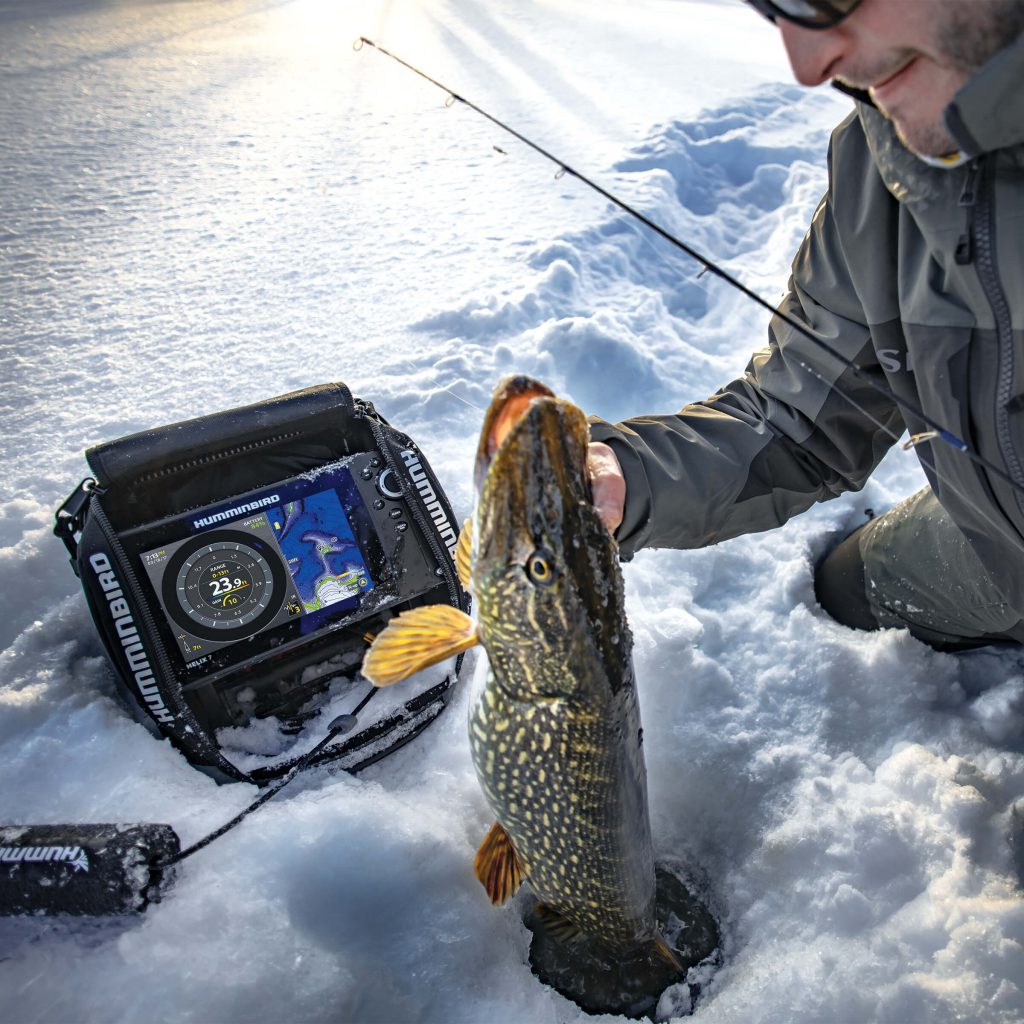
The first step in using an ice fishing fish finder is to drill a hole in the ice. Choosing the right place to drill depends to some extent on your knowledge of the lake you’re on and the fish it contains. If you know that the lake is relatively deep and fish like to hide at the bottom of it, you’ll need to go out towards the center of the lake before drilling a hole.
On the other hand, if fish tend to congregate in areas around the shore, you’ll want to drill your hole closer to shore. In that case, make sure you’re drilling in an area where the ice is solid and can safely hold your weight even after you drill through it.
Once you’ve got a hole, it’s time to put the transducer into the water. Make sure your transducer is completely below the level of the ice, as the ice hole itself can interfere with the sonar beams and create a murky signal. If you know the depth of the lake at the spot you’re at, now is a good time to adjust the frequency of your fish finder or the depth setting of your fish flasher.
At this point, you probably want to use a wide beam angle if your fish finder allows it. That way, you can get information about the widest possible area around you – chances are, you didn’t happen to drill your hole right over the exact spot where fish tend to congregate. If your sonar has a downscanning beam as well, you can switch to that and see what’s at the bottom of the lake below you.
Now that you’ve had a good look at what’s going on under the ice surface, you should have a better idea of the depths and locations that fish are hiding at. You’ll want to move over to roughly where the sonar indicated they are at. Then, depending on how confident you are, you can drill another small hole and set up your fish finder again. This time, you should be able to hone in on fish right below you relatively quickly – if you’ve managed to get right over them, you can drill a wider hole for fishing directly adjacent to your fish finder hole.
Our three overall favorite fish finders for ice fishing are the Humminbird ICE-35, the MarCum M Series Flashers, and the Garmin Echomap Chirp 94SV with Transducer
The Garmin Echomap Chirp 94SV is an ideal choice for fishermen who want to use the same fish finder no matter what the season. It is quite portable, has incredibly high resolution, and comes with built-in maps for coastal fishing.
The MarCum M Series Flashers is an impressive unit for ice fishing, as it offers 30-hour lasting battery, and, combined with M-series sonar, it will make your fishing truly effective.
We feel that the Humminbird ICE-35 is the overall best ice fishing fish finder on the market today thanks to its impressive flasher display, 2D sonar, and mapping capabilities. Even better, the Humminbird flasher can eliminate interference from nearby CHIRP sonars.
